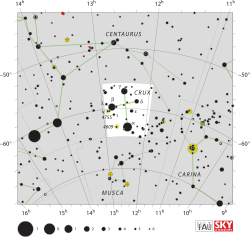Gamma Crucis
| Observation data Epoch J2000.0 Equinox J2000.0 |
|
|---|---|
| Constellation | Crux |
| Right ascension | 12h 31m 09.95961s |
| Declination | −57° 06′ 47.5684″ |
| Apparent magnitude (V) | +1.64 |
| Characteristics | |
| Spectral type | M3.5 III |
| Apparent magnitude (J) | −1.99 |
| U−B color index | +1.78 |
| B−V color index | +1.59 |
| Variable type | SRV |
| Astrometry | |
| Radial velocity (Rv) | +20.6 km/s |
| Proper motion (μ) |
RA: +28.23 mas/yr Dec.: −265.08 mas/yr |
| Parallax (π) | 36.83 ± 0.18mas |
| Distance | 88.6 ± 0.4 ly (27.2 ± 0.1 pc) |
| Absolute magnitude (MV) | −0.52 |
| Details | |
| Mass | 1.3 ± 0.1 M☉ |
| Radius | 84 R☉ |
| Luminosity | 1,500 L☉ |
| Temperature | 3,626 K |
| Other designations | |
| Database references | |
| SIMBAD | data |
Gamma Crucis (γ Crucis, abbreviated Gamma Cru, γ Cru), also named Gacrux, is the nearest red giant star to the Sun. The distance to Gacrux has been determined using parallax measurements made during the Hipparcos mission, which yielded a value of 88.6 light-years (27.2 parsecs) away from the Sun. With an apparent visual magnitude of +1.63, this is the third-brightest star in the southern circumpolar constellation of Crux, the Southern Cross, and one of the brightest stars in the night sky. A line from the two "Pointers", Alpha Centauri through Beta Centauri, leads to within a few degrees of this star.
γ Crucis (Latinised to Gamma Crucis) is the star's Bayer designation.
Since Gamma Crucis is at roughly −60° declination, it lacks a traditional name. Nonetheless, it was known to the ancient Greeks and Romans, in whose era it was visible north of 40° latitude due to the precession of equinoxes. The astronomer Ptolemy counted it as part of the constellation of Centaurus. The historical name Gacrux is a contraction of the Bayer designation, coined by astronomer Elijah Hinsdale Burritt (1794-1838). In 2016, the International Astronomical Union organized a Working Group on Star Names (WGSN) to catalog and standardize proper names for stars. The WGSN's first bulletin of July 2016 included a table of the first two batches of names approved by the WGSN; which included Gacrux for this star.
...
Wikipedia

